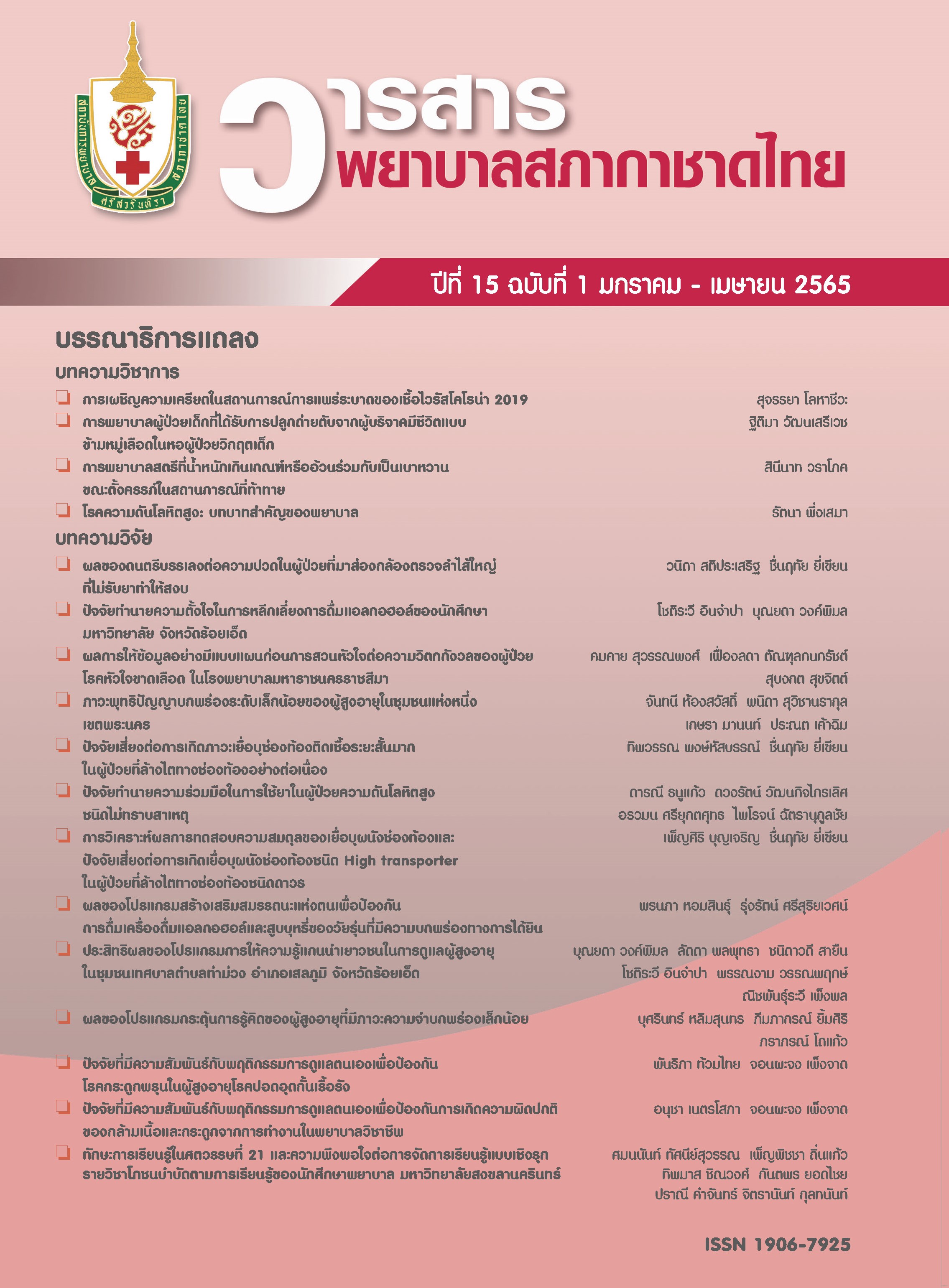Effect of Preparatory Information on Anxiety Among Patients Undergoing Coronary Angiograms at Maharat Nakhon Ratchasima Hospital
Keywords:
coronary angiogram, anxiety, preparatory informationAbstract
This quasi-experimental design aimed to study the effect of preparatory information on anxiety among patients undergoing coronary angiograms at Maharat Nakhon Ratchasima Hospital. Sampling based on the inclusion criteria was used and samples were divided into an experimental group and a control group with 20 persons each. The experimental group received preparatory information based on concepts developed by Leventhal and Johnson. The control group received information based on usual care. Research instruments included a Demographic Questionnaire, a Spielberger State-Trait Anxiety Inventory scale before and after the intervention, a structured information program based on the Leventhal and Johnson conceptual framework by individuals educated through multimedia and QR-code Self-review via smartphone while in hospital. Data were analyzed by descriptive statistics, dependent and independent t-test statistics. The results of this study showed that the mean score of anxiety in the experimental group after receiving preparatory information on anxiety was significantly lower than that before receiving preparatory information on anxiety (P < .001). The mean score of anxiety for the experimental group was statistically lower than that the control group after receiving preparatory information on anxiety (P < .05).
In conclusion, preparatory information effectively reduces anxiety in patients lower than those receiving information from usual care. Therefore, preparatory information should be applied to prepare patients to reduce anxiety and promote protocol adherence.
References
World Health Organization. WHO reveals leading causes of death and disability worldwide: 2000-2019 [Internet]. 2020 [ cited 2022 Apr 10]. Available from: https://www.who.int/news/item/09-12-2020who-reveals-leading-causes-of-death-and-disability-worldwide-2000-2019
Ministry of Public Health. Public health statistics 2017. Nonthaburi: Division of Strategy and Planning; 2018. (in Thai)
Cardiovascular Intervention Unit, Maharat NakhonRatchasima Hospital. Information of procedure cardiovascular room 2-4. Nakhon Ratchasima: Cardiovascular Intervention Unit; 2019. (in Thai)
Buzatto LL, Zanei SSV. Patients’ anxiety before cardiac catheterization. Einstein 2010; 8(4):483-87.
Delewi R, Vlastra W, Rohling WJ, Wagenaar TC, Zwemstra M, Meesterman MG, et al. Anxiety levels of patients undergoing coronary procedures in the catheterization laboratory. Int J Cardiol 2017;228:926–30. doi: 10.1016/j.ijcard.2016.11.043.
Trotter R, Gallagher R, Donoghue J. Anxiety in patients undergoing percutaneous coronary interventions. Heart Lung 2011;40(3):185-92. doi: 10.1016/j.hrtlng.2010.05.054.
Leventhal H, Johnson JE. Laboratory and field experiment of a theory of self - regulation. In: Wooldridge PJ, Schmitt MH, Skipper JK, Leonard RC, editors. Behavioral science and nursing theory. St. Louis: The C.V. Mosby; 1983. p.189-282.
Somsiri V, Suseng J. The Effect of giving planned instruction on knowledge perceived self-care abilities and self-care behavior in coronary heart disease patients receiving percutaneous coronary intervention at Songkhlanakarind Hospital. Princess of Naradhivas University Journal 2011;3(3):33-46. (in Thai)
Pattanajak C, Ruaisungnoen W. Effect of preparatory information on anxiety and procedural adherence among patients undergoing coronary angiogram. Journal of Nursing Science and Health 2018;41(3):10-9. (in Thai)
Aboalizm SE, El Gahsh NF, Masry SE. Effect of early nursing preparation on anxiety among patients undergoing cardiac catheterization. Am J Nurs Sci 2016;5(5):222-31.
Adib Hajbaghery M, Moradi T, Mohseni R. Effects of a multimodal preparation package on vital signs of patients waiting for coronary angiography. Nurs Midwifery Stud 2014; 3(1):e17518. doi: 10.17795/nmsjournal17518.
Jamshidi N, Abbaszadeh A, Najafi Kalyani N, Sharif F. Effectiveness of video information on coronary angiography patients’ outcomes. Collegian 2013;20:153-59.
Rosner B. Fundamentals of biostatistics. 5th ed. Pacific Grove, CA: Duxbery; 2000.
Polit DF, Beck CT. Nursing research: generating and assign evidence for nursing practice. 8th ed. Philadelphia: Lippincott; 2008.
Spielberger C, Gorsuch R, Lushene R, Vagg PR, Jacobs G. Manual for the state-trait anxiety inventory. Palo Alto, CA: Consulting Psychologist; 1983.
Tapinta D. Reduction of anxiety of staff nurses working with AIDS patients through cognitive recon structuring and mindfulness training [Dissertation]. Bangkok: Chulalongkorn University; 1992. (in Thai)
Moradi T, Adib‐Hajbaghery M. The effect of a multi-modal preparation package on anxiety in patients undergoing coronary angiography. Int Cardiovasc Res J 2015;9(1): 10-6.
Moradi T, Adib‐Hajbaghery M. State and trait anxiety in patients undergoing coronary angiography. International Journal of Hospital Research 2015;4(3):123-28.
Wongmanee K, Sirichana W. Effect of structured information on anxiety among family caregivers of patients with respiratory disease using oxygen delivery devices. Thai Red Cross Nursing Journal 2020;13(1):163-78. (in Thai)
Arunyavas D, Tribuddharat S, Sathikarnmanee T, Palachewa K. The effect of systematic anesthetic informed consent on anxiety level in patients undergoing general anesthesia. Thai J Anesthesiology 2012;38(2):102-8. (in Thai)
Downloads
Published
Issue
Section
License
Copyright (c) 2022 Srisavarindhira Thai Red Cross Institute of Nursing

This work is licensed under a Creative Commons Attribution-NonCommercial-NoDerivatives 4.0 International License.
เนื้อหาบทความหรือข้อคิดเห็นต่างๆ ในวารสารพยาบาลสภากาชาดไทยนี้ เป็นความคิดเห็นของผู้เขียนบทความ ไม่ใช่ความเห็นของกองบรรณาธิการ หรือสถาบันการพยาบาลศรีสวรินทิรา สภากาชาดไทย






